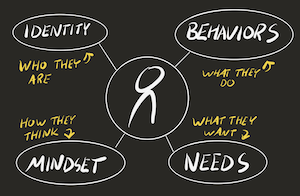


“Customer-focused content” is one of our agency’s 2019 content trends to watch.
All year we’ve seen our clients commit to becoming more customer-focused. They’ve pledged to better understand their customers’ needs and goals. Identify their biggest challenges. And map their customers’ and prospects’ behaviors and interactions with their brand.
A customer-focused marketing approach doesn’t happen overnight. But you can quickly shift to a customer-focused mentality.
There was a great presentation at Confab Central this year that changed the way I work. Scott Kubie’s User-Centered Tools and Tactics talk was awesome! I have reread my conference notes nearly every week. Scott has kindly agreed to let me share some of the highlights.
If you’re new to a customer-focused approach to content, don’t get overwhelmed by everything you don’t have or need to do. Just pick an area that interests you and get started.
Being customer-focused has two big benefits for your content: focus and consistency.
When you’re focused on your priority customers and prospects, you can direct the conversation toward what they want. And kill what is not relevant. That’s not only a smart approach but also very freeing. If your customers don’t care, don’t create it.
It also helps with consistency. Creating a content strategy focused on your customers means that two years from now, your writers and designers are still creating content with that audience in mind. They’re not changing course and reacting to the whims of your business. They’re focused on who matters and what matters to them.
Four buckets help organize your customer information and insights:
To determine your customers’ identities, you need to give them a name. Create portraits of them that include their vocabulary, affiliations, and a realistic backstory.
Use photos, videos, and audio files of real-life people to help your team understand the human beings you’re trying to reach. And don’t just listen to them; define their vocabulary. What words do they use? What words make sense for your brand to use?
How your customers think and feel creates their mindset. Your goal is to help define things like their mood, trust level, confidence, and values.
Mindset can be a difficult concept to translate. Start with your personas. Schedule a group workshop to discuss each persona. Think about what they’re thinking and feeling during the customer journey stages.
Map those thoughts and feelings by creating customer journey or empathy maps. What have they heard from your brand or others? What are they seeing? What do they say and do about it?
What drives your customers? What do they want? What do they need?
Your customers don’t need your new product or your website; they need a solution to their problem or an exciting new opportunity or idea. Start with your customers’ goals. Write a customer story for every persona that defines and prioritizes their need:
As a _____________, I want to _________________ so that I _______________________.
Then write a job story for them:
When (situation), I want to (action) to achieve (my goal).
A great way to represent your customers’ needs is through quotes. Quotes are incredibly powerful. Use them often to help your team understand your customers and their needs.
What are your customers doing? Think about their actions, decisions, paths, habits, and events. Show behavior through storyboards, story mapping, content ecosystem maps, and journeys.
A customer-focused approach to content starts with you. Look for opportunities to work these ideas into your projects. Scott’s blog post, Assessing Your User-Centered Content Strategy has some good tips to get you started.
Start by reorganizing your persona layouts around the four buckets: identity, mindset, needs, and behavior. As time and budgets allow, build more of the tools. But for now, it’s a starting place for your team to adopt a customer-focused mentality.
Have questions about starting a customer-focused content strategy, reach out to us. We’re always excited to talk about content!